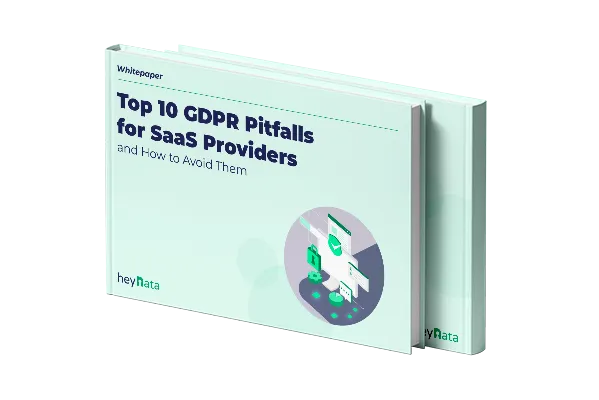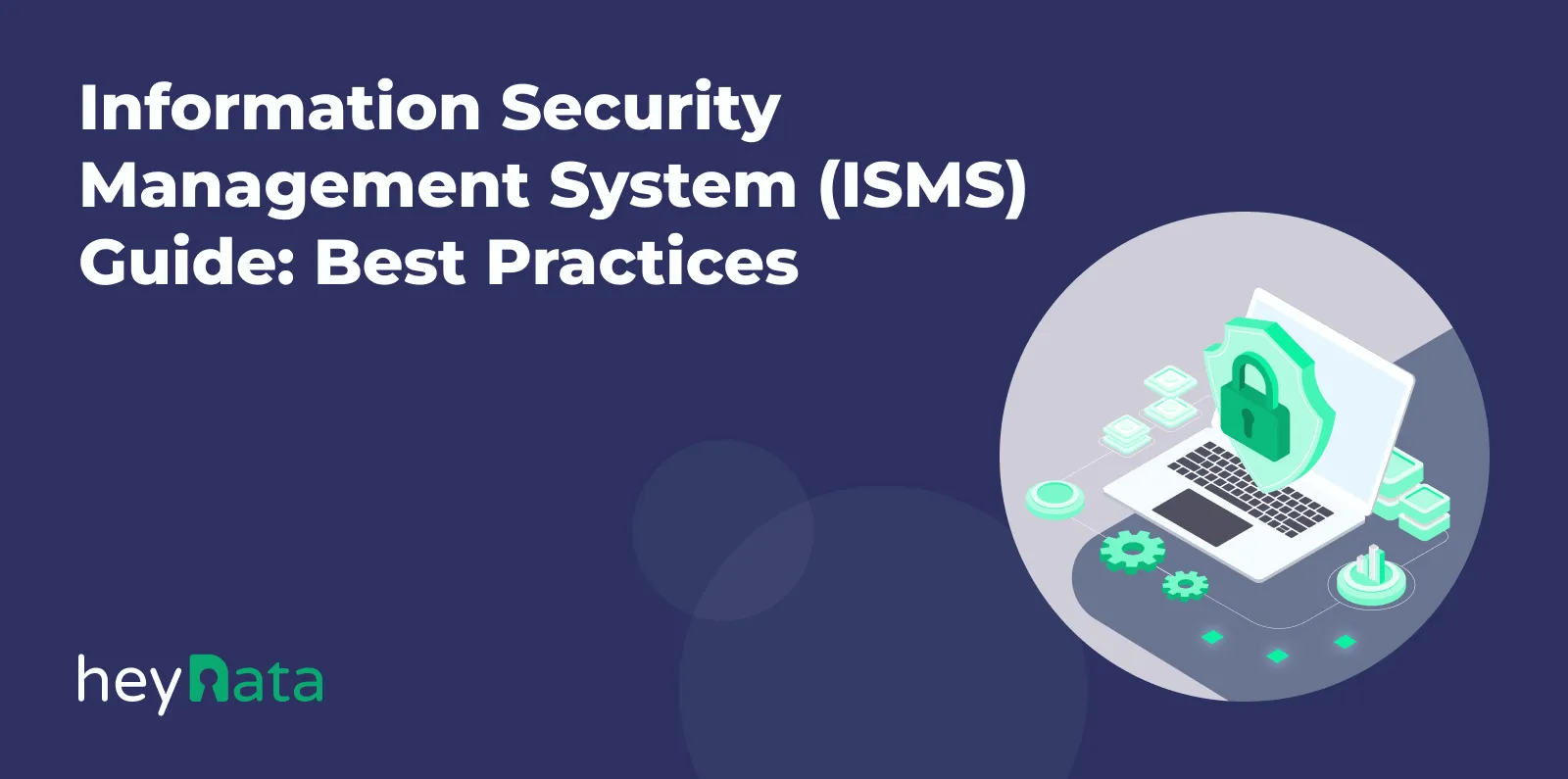
The 10 most common GDPR mistakes made by SaaS companies – are you impacted?

Information Security Management System (ISMS) for SMEs: Best Practices & Implementation

'%3e%3cpath%20d='M26.6667%2020.022L30%2023.3553V26.6886H21.6667V36.6886L20%2038.3553L18.3333%2036.6886V26.6886H10V23.3553L13.3333%2020.022V8.35531H11.6667V5.02197H28.3333V8.35531H26.6667V20.022Z'%20fill='%230AA971'/%3e%3c/g%3e%3c/svg%3e) Key Takeaways
Key Takeaways
- What is ISMS?
A structured system to manage sensitive information, ensuring confidentiality, integrity, and availability. - Why it matters for SMEs:
Cyber threats are growing, and ISMS helps SMEs stay secure and compliant with standards like ISO 27001. - Best practices covered:
Access control, encryption, employee training, internal audits, device and backup security. - Framework guidance:
How to implement an ISO 27001-based ISMS, from risk assessments to monitoring and continuous improvement.
In today's rapidly evolving digital landscape, information security has become a critical concern for organizations of all sizes. The increasing frequency and sophistication of cyber threats, coupled with stringent regulatory requirements, have made it essential for businesses to implement robust security measures. An Information Security Management System (ISMS) provides a systematic approach to managing sensitive company information, ensuring its confidentiality, integrity, and availability.
In addition to international standards, European SMEs must also consider the EU NIS2 Directive, which came into effect in January 2024. It mandates enhanced cybersecurity measures and reporting obligations for entities in essential sectors, implementing an ISMS not just a best practice, but a legal requirement for many organizations operating within the EU.
This comprehensive guide explores the fundamental aspects of ISMS, its implementation, and best practices, particularly focusing on how Small and Medium-sized Enterprises (SMEs) can establish effective information security frameworks to enhance their security posture in an increasingly interconnected world.
Related blog: Ultimate Guide: What is Information Security Management System (ISMS)?
Table of Contents:
Information Security Management System (ISMS) Best Practices
Understanding business needs is fundamental before implementing an ISMS. Organizations must thoroughly assess their operations, tools, and existing security systems to identify requirements and determine how the ISO 27001 framework can enhance their data protection strategy.
Establishing Security Policy
Establishing a comprehensive information security policy serves as the foundation of effective security management. This policy should provide a clear overview of security controls and governance framework while outlining specific roles and responsibilities for all stakeholders involved.
Access Control Monitoring
Implementing robust access control monitoring ensures that only authorized personnel can access sensitive information. Organizations must track and record who accesses data, when it occurs, and from which location, including monitoring login activities and authentication processes.
Device Security
Device security requires implementing protective measures against physical damage and cyber threats. Organizations should utilize enterprise-grade security tools and ensure all devices have appropriate security software and configurations.
Data Encryption
Data encryption serves as a critical defense mechanism against unauthorized access. Organizations must implement comprehensive encryption protocols for all sensitive data, both in transit and at rest, to prevent potential security breaches.
Data Backup Procedures
Maintaining regular data backups is crucial for business continuity. Organizations should establish clear backup procedures, including frequency and storage locations while ensuring both on-premises and cloud backups are properly secured.
Internal Security Audits
Regular internal security audits help organizations maintain visibility over their security infrastructure. These assessments identify potential vulnerabilities and ensure compliance with established procedures, enabling continuous improvement of security measures.
Continuous Employee Training
Employee training must be ongoing and comprehensive, focusing on practical security awareness. Regular sessions should cover emerging threats, best practices, and incident response procedures, fostering a security-conscious culture throughout the organization. It should now also cover emerging topics like AI risk awareness, use of generative models, and ethical data handling practices in line with the EU AI Act and GDPR expectations.
Through these practices, organizations can develop a robust ISMS that effectively protects sensitive information while supporting business objectives. Regular review and updates of these practices ensure the ISMS remains effective against evolving security threats.
Related blog: ISO 27001: The Ultimate Guide to Compliance and Certification

The 10 most common GDPR mistakes made by SaaS companies – are you impacted?
Information Security Management System Framework
The ISO/IEC 27001 framework serves as the global benchmark for Information Security Management Systems (ISMS). This internationally recognized standard provides organizations with a systematic approach to managing sensitive information assets, incorporating both cybersecurity and data protection measures. The latest revision, ISO/IEC 27001:2022, introduces updated control categories, improved alignment with ISO/IEC 27002:2022, and a stronger emphasis on organizational resilience, continuous improvement, and threat-based risk management.
Key Elements of an Effective ISMS Framework
- Information Security Policies: Comprehensive documentation outlining security objectives, roles, and responsibilities.
- Risk Management: Systematic approach to identifying, assessing, and mitigating security risks.
- Asset Management: Inventory and classification of information assets requiring protection.
- Access Control: Implementation of user authentication and authorization mechanisms.
- Incident Management: Procedures for detecting, reporting, and responding to security incidents.
Customizing the Framework
Organizations must adapt the framework to their specific context while considering industry-specific regulations and compliance requirements, organization size and resource availability, technical infrastructure and capabilities, as well as business objectives and risk appetite.
Regular reviews and updates ensure the framework remains effective and aligned with evolving security threats and business needs. Sources include ISO.org, NIST Cybersecurity Framework, and industry best practices from leading security organizations.
Implementing Information Security Management System
Implementing an effective Information Security Management System (ISMS) involves several critical steps:
1. Initial Assessment and Planning
Maintain an ongoing review process for the ISMS based on changes in business operations or emerging threats. Adapt security measures accordingly to ensure effectiveness over time.
2. Scope and Objectives Definition
Defining the scope and objectives is crucial as it aligns ISMS implementation with organizational goals while identifying specific information assets, processes, and stakeholders that need protection.
3. Risk Assessment
A comprehensive risk assessment evaluates potential threats and vulnerabilities to sensitive data, enabling organizations to prioritize and implement necessary security controls effectively.
4. Policy and Procedure Development
Well-documented policies and procedures serve as the foundation for information security governance, addressing critical areas such as data access controls, incident response protocols, and compliance requirements specific to the organization.
5. Control Implementation
Implementation of robust technical and organizational controls ensures proper protection of information assets through various measures, including data access monitoring, encryption protocols, and user authentication systems.
6. Employee Security Training
Regular security awareness training sessions help build a strong security culture by educating employees about best practices, potential threats, and their role in maintaining information security.
7. System Monitoring
Continuous monitoring of systems and compliance with established policies enables early detection of security anomalies and potential breaches, allowing for prompt remediation actions.
8. Review and Update
Regular review and updates of the ISMS ensure its continued effectiveness by adapting security measures to address changes in business operations and emerging threats in the cybersecurity landscape.
By following these steps, organizations can effectively implement an ISMS that not only safeguards sensitive information but also enhances overall operational resilience against cybersecurity threats.
Your Journey to Compliance
heyData provides SMEs with the confidence needed to navigate the complexities of information security management. Our solutions include expert assessment, and implementation support, complemented by specialized employee compliance training programs, internal audits, and documentation assistance. With heyData's tailored solution, businesses can enhance their security posture and achieve compliance efficiently, while focusing on their core operations.
Conclusion
As cyber threats continue to grow in sophistication and frequency, maintaining a dynamic ISMS is fundamental to organizational success. It serves as the cornerstone of modern business operations, fostering a culture of security consciousness while strengthening corporate reputation. By investing in a comprehensive ISMS today, organizations not only protect their current assets but also build a resilient foundation for sustainable future growth in an increasingly interconnected world.
Frequently Asked Questions (FAQs)
What is an ISMS (Information Security Management System)?
An ISMS is a structured framework of policies, procedures, and controls designed to manage and protect sensitive information within an organization.
Why is ISMS important for SMEs?
It helps SMEs protect data, meet compliance standards like ISO 27001, and improve operational resilience against cyber threats.
How do I start implementing an ISMS?
Begin with a risk assessment, define objectives, establish policies, implement controls, train employees, and monitor progress continuously.
What standard is used for ISMS?
ISO/IEC 27001 is the internationally recognized standard used to implement and certify an effective ISMS.
How often should an ISMS be reviewed?
At least annually or whenever there are significant changes in your organization’s structure, operations, or threat landscape.
Does heyData help with ISMS compliance?
Yes! heyData offers expert support, including implementation, audits, employee training, and documentation for SMEs.
Important: The content of this article is for informational purposes only and does not constitute legal advice. The information provided here is no substitute for personalized legal advice from a data protection officer or an attorney. We do not guarantee that the information provided is up to date, complete, or accurate. Any actions taken on the basis of the information contained in this article are at your own risk. We recommend that you always consult a data protection officer or an attorney with any legal questions or problems.


